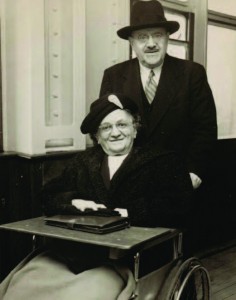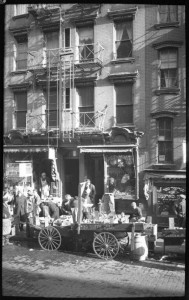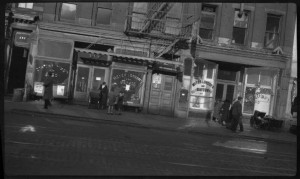Rabbi Herbert S. Goldstein: A Powerful Voice of Tradition
Since its establishment in 1898, the OU has had one overriding goal: to strengthen and fortify traditional Jewry. Over the years, the OU has addressed the broad range of challenges facing American Orthodox life, combating intermarriage and assimilation, making kosher certification more reliable, advocating for Israel, unifying and supporting synagogues, reaching teens and college youth, promoting Orthodox Jewish values in the public square and assisting the Jewish disabled.
Back in the early part of the twentieth century, the Union’s concerns—advancing Shabbat observance, building Talmud Torahs and struggling to effectively transmit the Jewish heritage to a generation of Americanized youth—reflected the then-fragile condition of American Orthodoxy. The state of kosher certification, which was riddled with corruption, posed another great threat to traditional life. However, in 1924, the Union undertook a monumental, unprecedented endeavor: the establishment of the first nonprofit kosher certification agency. This would ultimately help revolutionize the kosher food industry.
During these tumultuous times in American Jewish history, Rabbi Herbert S. Goldstein, who was president of the Orthodox Union from 1924 to 1933, served as a powerful voice of tradition and spiritual resilience. Rabbi Goldstein’s devoted wife, Rebecca, was a cofounder of the OU’s Women’s Branch and its national president for thirteen years. The daughter of philanthropist Harry Fischel, Rebecca was instrumental in helping her husband establish the OU’s kashrut program, among many other initiatives.

The OU’s “power couple” in the 1920s: Rabbi Goldstein and his wife, Rebecca. With her impressive organizational skills and passion for Jewish life, Rebecca, it was noted, was able to accomplish more than ten men working together even after health conditions forced her into a wheelchair in her later years. Photo courtesy of Rabbi Aaron Reichel
In November 1927, Rabbi Goldstein delivered an impassioned speech at the OU National Convention in New York City. After addressing topics such as the dire need to establish a youth group for teens and to provide rabbis on college campuses, Rabbi Goldstein stressed the critical role Talmud Torahs played as the primary vehicle of Jewish education in the days preceding the day school movement. Rabbi Goldstein spoke about the OU organizing Talmud Torahs in small towns and rural communities “where none exist” and even subsidizing the teachers’ salaries. He then turned to two of the most pressing challenges confronting American Jews in the early part of the twentieth century: Shabbat and kashrut. Working with unions to establish a five-day workweek to help promote the observance of Shabbat was a top priority for the Union in the 1920s:
One of the chief problems which confront American Jewry today is that of the Sabbath. I have been in touch with the labor leaders of the fur industry and we have been assured every cooperation. I am happy to report that in the above-mentioned industry, no furrier must work on the Sabbath. A forty-hour or five-day workweek has been instituted. We have cooperated with the International Ladies’ Garment Workers’ Union in their fight for an eight-hour [day] and five-day workweek . . .
The five-day workweek, fellow delegates, is the solution to the Jewish religious problem in America. We cannot do anything greater than to consecrate ourselves toward this end. The five-day workweek will mean the spiritual reawakening of America. It will mean to the Christian as well as to the Jew the restoration of a spiritual Sabbath. Golf, and all the secular sports and pursuits, will be indulged in on one day, and the synagogue and church will be the common uplift ground on the other day. Woe to a nation that will fail to encourage its citizens to become in fact, and in practice, a Sabbath-observing people. America is fast becoming Sabbath-less, a pagan people.
Rabbi Goldstein goes on to speak about kashrut:
Through our successful efforts, not only was the Kosher Law introduced and passed in the State of New York and declared constitutional by the Supreme Court, but we are also instrumental in aiding other states to enact similar legislation giving us police power to protect the Jewish communities from bootleg kosher meat. [I] spoke on behalf of the enactment of the Kosher Law for Wisconsin before the Senate Committee of the legislature in Madison, Wisconsin. We have since heard that our regional branch there brought to successful fruition the passage of the bill. We are now aiding Ohio in a similar direction.
Through the tireless energies of Mr. Abraham Goldstein of our Executive Committee, a large number of firms are applying to us for our supervision and endorsement for kashruth . . . In addition to the kosher crackers of the Loose-Wiles Sunshine Biscuit Company, we have persuaded Heinz (of 57 Varieties fame) to place on the labels of such of their products, twenty-six in number, as do not contain animal fat and which are periodically inspected by us, the letter U in the letter O, indicating Orthodox Union. We have under our supervision Sheffield’s Kosher butter, Duggan’s whole-wheat bread and cakes, in the states of New Jersey and New York, The Land O’Lakes Butter and Taburg Bros. Inc. vegetable fat, preserves and an entire line of kosher products for bakers’ and restaurants’ use . . .
Eighty-six years later, Rabbi’s Goldstein’s words about holding steadfast to religious life and withstanding the various temptations of modernity remain as relevant as ever:
The future of American Jewry in this country will rise or fall in proportion to its loyalty to Judaism. The Jewish people have never been dependent upon outward material conditions. We need never fear any outer enemy, so long as we remain faithful to God and His holy Torah. No human agency can interfere with the indestructibility of Israel so long as Israel is true to the source of its own indestructibility—the Torah.
As president of the Union of Orthodox Jewish Congregations of America, I summon the Jews of this country back to the ancient Jewish faith. Our faith is ancient and, at the same time, modern, just as Truth is ever old yet ever new. Every generation has called itself modern. The fifteenth century was the modernity of its time and the twentieth century is the modernity of our time. Yet the Torah in its completeness has lived through all these modernities because it is Truth.
American institutions have been founded upon the Divine plan as handed down to Israel. The pristine spirit of the Puritans, which marked the foundation of America, was nurtured in the Jewish soul. Our American ancestors founded this country upon the pattern of Judaism. We, in turn, must now make America safe for the Torah.


